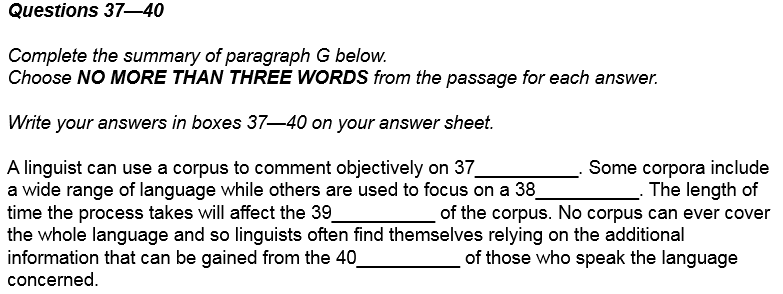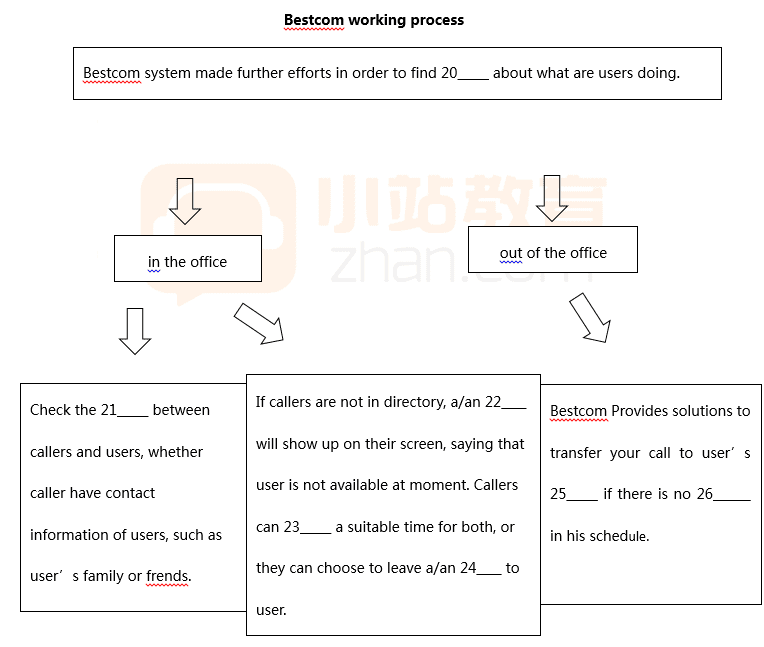雅思閱讀選詞摘要題型是怎樣的呢?下面小編給大家帶來了雅思閱讀選詞摘要題的出題特點、解題步驟講解,希望能夠幫助到大家,下面小編就和大家分享,來欣賞一下吧。
雅思閱讀選詞摘要題的出題特點、解題步驟講解
出題特點:
題型特點:
考查范圍分部分考查與全文考查。框中摘要題有可能是對文章局部內容的考查,比如某一段或某幾段,也有可能是對整篇文章的考查。
備選項特點:
備選項的個數大于空格個數;
如果題目中有說明,則有的備選項會重復被選用。
順序原則:
大多數空格順序與空格答案在原文中出現的順序一致。
答案特點:
答案多為名詞或名詞詞組。
解題步驟:
①審題
題目中給出了摘要題在文中對應的段落的,在對應段落內定位分析;題目中沒有給出摘要題在文中對應的段落的,需要根據題目的標題或是摘要第一句話的主要內容大致劃定題目在文章中的對應位置。
注意題目要求是在空格中填入框中單詞或詞組本身還是填入框中單詞或詞組對應的字母。
如果題目說明中出現“NB You may use any word more than once”。則說明該摘要題中有的選項會重復使用。
②空格詞性預判
根據空格前后的詞性進行判斷, 如adj+(n),n+(n),v+(n)等結構;
也可根據句子成分進行判斷,如空格為主語成分,基本為名詞,表語成分基本為形容詞
? 定位關鍵詞并分析定位句
找到空格所在句子的關鍵詞,并定位到文中相應位置對定位句進行分析。
注意空格所在句子中關鍵詞與原文中的關鍵詞替換;或空格所在句子的關鍵詞是對原文定位句的同義概括。
? 寫出答案
結合關鍵定位句和空格所在的句子內容得出答案。
雅思閱讀選詞摘要題講解--The Little Ice Age
THE LITTLE ICE AGE
A
This book will provide a detailed examination of the Little Ice Age and other climatic shifts, but, before I embark on that, let me provide a historical context. We tend to think of climate - as opposed to weather - as something unchanging, yet humanity has been at the mercy of climate change for its entire existence, with at least eight glacial episodes in the past 730,000 years. Our ancestors adapted to the universal but irregular global warming since the end of the last great Ice Age, around 10,000 years ago, with dazzling opportunism. They developed strategies for surviving harsh drought cycles, decades of heavy rainfall or unaccustomed cold; adopted agriculture and stock-raising, which revolutionized human life; and founded the world's first pre-industrial civilizations in Egypt, Mesopotamia and the Americas. But the price of sudden climate change, in famine, disease and suffering, was often high.
B
The Little Ice Age lasted from roughly 1300 until the middle of the nineteenth century. Only two centuries ago, Europe experienced a cycle of bitterly cold winters; mountain glaciers in the Swiss Alps were the lowest in-recorded memory, and pack ice surrounded Iceland for much of the year. The climatic events of the Little Ice Age did more than help shape the modern world. They are the deeply important context for the current unprecedented global warming. The Little Ice Age was far from a deep freeze, however; rather an irregular seesaw of rapid climatic shifts, few lasting more than a quarter-century, driven by complex and still little understood interactions between the atmosphere and the ocean. The seesaw brought cycles of intensely cold winters and easterly winds, then switched abruptly to years of heavy spring and early summer rains, mild winters, and frequent Atlantic storms, or to periods of droughts, light northeasterly winds, and summer heat waves.
C
Reconstructing the climate changes of the past is extremely difficult, because systematic weather observations began only a few centuries ago, in Europe and North America. Records from India and tropical Africa are even more recent. For the time before records began, we have only 'proxy records' reconstructed largely from tree rings and ice cores, supplemented by a few incomplete written accounts. We now have hundreds of tree-ring records from throughout the northern hemisphere, and many from south of the equator, too, amplified with a growing body of temperature data from ice cores drilled in Antarctica, Greenland the Peruvian Andes, and other locations. We are close to knowledge of annual summer and winter temperature variations over much of the northern hemisphere going back 600 years.
D
This book is a narrative history of climatic shifts during the past ten centuries, and some of the ways in which people in Europe adapted to them. Part One describes the Medieval Warm Period, roughly 900 t0 1200. During these three centuries, Norse voyagers from Northern Europe explored northern seas, settled Greenland, and visited North America. It was not a time of uniform warmth, for then, as always since the Great Ice Age, there were constant shifts in rainfall and temperature. Mean European temperatures were about the same as today, perhaps slightly cooler.
E
It is known that the Little Ice Age cooling began in Greenland and the Arctic in about 1200. As the Arctic ice pack spread southward, Norse voyages to the west were rerouted into the open Atlantic, then ended altogether. Storminess increased in the North Atlantic and North Sea. Colder, much wetter weather descended on Europe between 1315 and 1319, when thousands perished in a continent-wide famine. By 1400, the weather had become decidedly more unpredictable and stormier, with sudden shifts and lower temperatures that culminated in the cold decades of the late sixteenth century. Fish were a vital commodity in growing towns and cities, where food supplies were a constant concern. Dried cod and herring were already the staples of the European fish trade, but changes in water temperatures forced fishing fleets to work further offshore. The Basques, Dutch, and English developed the first offshore fishing boats adapted to a colder and stormier Atlantic. A gradual agricultural revolution in northern Europe stemmed from concerns over food supplies at a time of rising populations. The revolution involved intensive commercial farming and the growing of animal fodder on land not previously used for crops. The increased productivity from farmland made some countries self-sufficient in grain and livestock and offered effective protection against famine.
F
Global temperatures began to rise slowly after 1850, with the beginning of the Modern Warm Period. There was a vast migration from Europe by land-hungry farmers and others, to which the famine caused by the Irish potato blight contributed, to North America, Australia, New Zealand, and southern Africa. Millions of hectares of forest and woodland fell before the newcomers' axes between 1850 and -1890, as intensive European farming methods expanded across the world. The unprecedented land clearance released vast quantities of carbon dioxide into the atmosphere, triggering for the first time humanly caused global warming. Temperatures climbed more rapidly in the twentieth century as the use of fossil fuels proliferated and greenhouse gas levels continued to soar. The rise has been even steeper since the early 1980s. The Little Ice Age has given way to a new climatic regime, marked by prolonged and steady warming. At the same time, extreme weather events like Category 5 hurricanes are becoming more frequent.
Questions 18-22
Complete the summary using the list of words, A-I, below.
Write the correct letter, A-I, in boxes 1-5 on your answer sheet.
Weather during the little Ice Age
Documentation of past weather conditions is limited: our main sources of knowledge of in the distant past are 18_____and 19_____.We can deduce that the Little Ice Age was a time of 20____, rather than of consistent freezing. Within it there were some periods of very cold winters, others of 21 ______ and heavy rain, and yet others that saw 22 _____ with no rain at all.
A climatic shifts B ice cores C tree rings
D glaciers E interactions F weather observations
G heat waves H storms I written accounts
真題精講:

長難句講解:
1. The Little Ice Age was far from a deep freeze, however, rather an irregular seesaw of rapid climatic shifts, few lasting more than a quarter-century,driven by complex and still little understood interactions between the atmosphere and the ocean.
參考譯文:然而,小冰期遠非一個深度冰凍期,它實際上是由大氣與海洋之間復雜難解的相互作用引起的,持續期普遍短語25年的一系列不規則氣候巨變的集合。
知識點:本題是summary題,far from表示“遠不是”,相當于“not merely”,因此這句話要強調的部分在however后面,即Little Ice Age是一個氣候變化迅速的時代。
2. We are close to a knowledge of annual summer and winter temperature variations over much of the northern hemisphere going back 600 years.
參考譯文:我們很快就要掌握北半球大部600年前的年度冬夏溫度的變化了。
知識點:We are close to (主謂)knowledge賓語介詞短語形式跟著定語 a knowledge of annual summer and winter temperature variations over much of the northern hemisphere going back 600 years.(部修飾說明前面整定語其going back 600 years置定語修飾northern hemisphere)
3. The revolution involved intensive commercial farming and the growing of animal fodder on land not previously used for crops.
參考譯文:這次革命帶來了集中的商業耕種,以及為了種植動物飼料而在非農作物用地上進行的土地開墾。
知識點:該句主干為the revolution involved---and---之后的not previously used for crops用來修飾land。
雅思閱讀選詞摘要題的出題特點、解題步驟講解相關文章:
★ 雅思閱讀簡答題解題技巧
★ 雅思閱讀考試技巧





